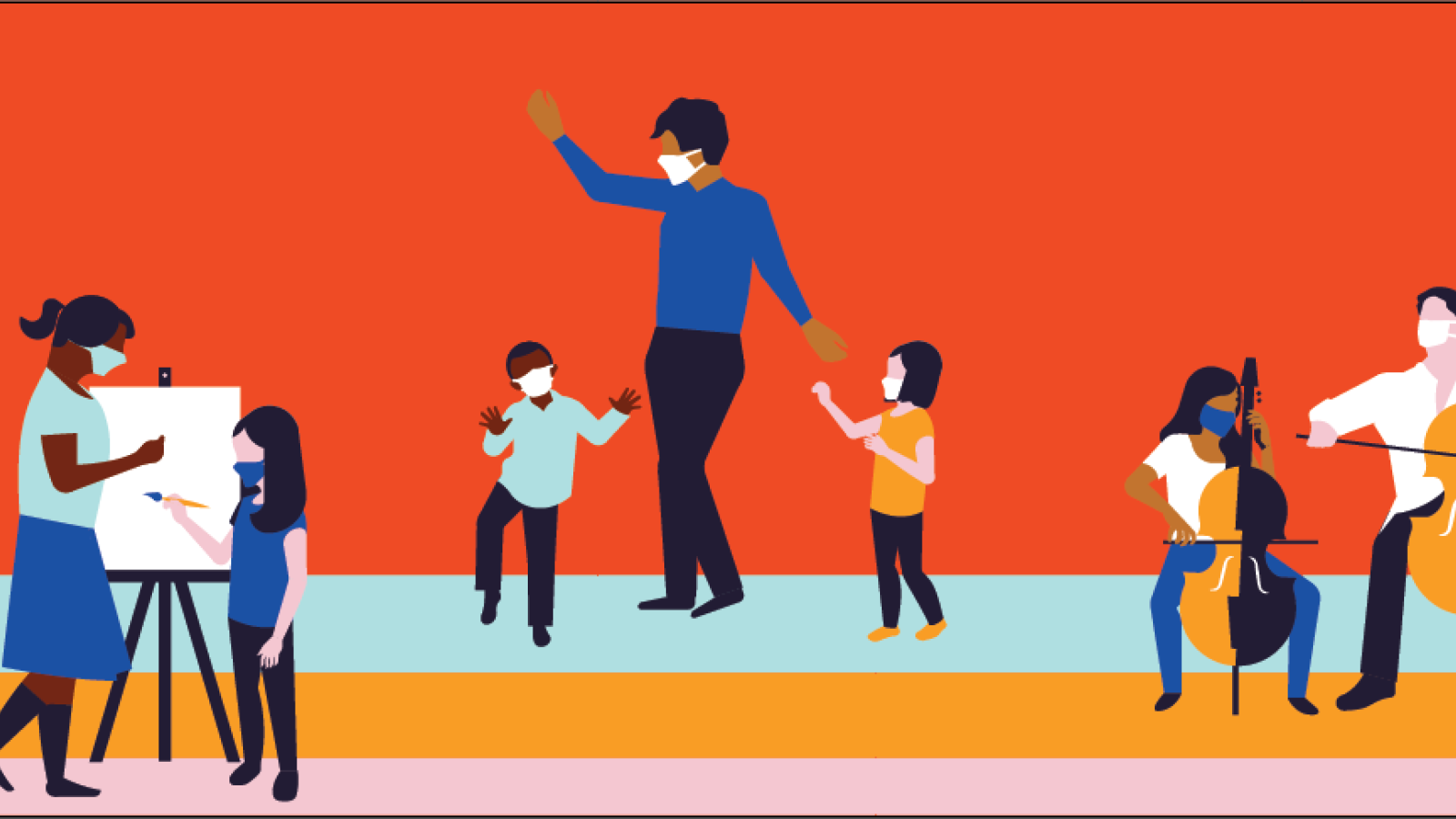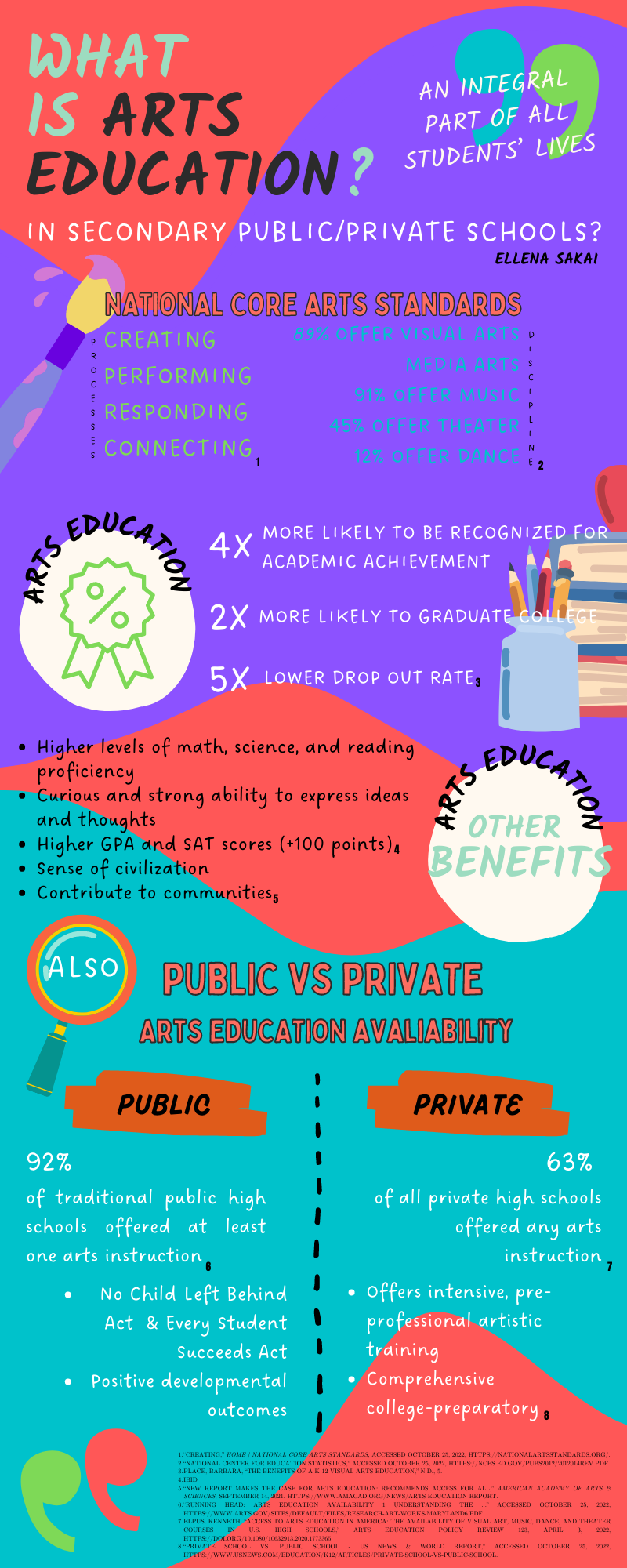The benefits of arts education for secondary school students cannot be overlooked. Formal art education was introduced in the mid-1820s across the United States, specifically in public schools. 91% of Americans believe that the arts are vital to providing a well-rounded education. (Americans for the Arts) The National Standards for Arts Education was written for all students in an initial publication in 1994 — new and improved standards were developed in 2014. The 2014 publication furnishes updated content, provides greater structure among art forms, and acknowledges the essential teaching role of technology. This article focuses on the national common core standards surrounding arts education and the intended benefits and impacts of them on visual art students in secondary education.
Arts Education Defined
Arts education allows and influences students to access creativity in ways that other subjects or courses may not. This form of education affects students, from a creative standpoint as well as in a physical and hands-on learning experience. An art class can be extremely beneficial for child/student communication, creative imagination, and thought process development. It is just as advantageous for improving fine motor skills. Students can transfer increasing levels of skills onto other areas of life and school. (Anaheim Elementary School District)
The arts are recognized in all grade levels of education as a core academic subject under the Federal Elementary and Secondary Education Act (2001 No Child Left Behind Act). All 50 states have embraced these learning standards. (Americans for the Arts, 2014) Policymakers, as well as education experts, believe that arts are a critical subject to which all students should be exposed. A partnership consisting of ten-plus national arts and education service organizations developed The National Coalition for Core Arts Standards (NCCAS). Organizations included Americans for the Arts, National Art Education Association, American Alliance for Theatre and Education, College Board, and more. The NCCAS mission is to deliver and create arts education opportunities for all pre-K-12 students. (Educational Theater Association Conference, 2014) The National Core Arts Standards “spell out what every young American should know and be able to do in the arts”, especially within the five disciples of dance, media arts, music, theatre, and visual arts. (Americans for the Arts, 2014)
Figure 1: Infographic Source: Author
Arts education standards
Standards within education act as clear measurable milestones for the disciplines. Not only do these expectations affect students’ learning, but they can also provide other stakeholders, such as educators and parents, opportunities to aim for their highest ability in skill and knowledge. The standards are built upon the following four artistic processes and include two levels of standards: Anchor and Performance Standards. These artistic processes prove and define the link between student-making and learning. (National Core Arts Standards, 2014)
Core Artistic Processes:
Creating: Conceiving and generating new artistic ideas and work
Performing: Realizing artistic ideas and work through interpretation and presentation
Responding: Understanding and evaluating how the arts convey meaning
Connecting: Relating artistic ideas and work with personal meaning and external context
Within these artistic processes, there are 11 anchor standards guiding students’ arts education. The performance standards are statements voicing student achievements in a particular discipline by the end of a grade. (National Core Arts Standards, 2014) The following are the 11 anchor standards divided into the four artistic processes.
Anchor Standards
Creating:
Anchor Standard 1: Generate and conceptualize artistic ideas and work
Anchor Standard 2: Organize and develop artistic ideas and work
Anchor Standard 3: Refine and complete artistic work
Presenting:
Anchor Standard 4: Select, analyze, and interpret artistic work for presentation
Anchor Standard 5: Develop and refine artistic techniques and work for presentation
Anchor Standard 6: Convey meaning through the presentation of artistic work
Responding:
Anchor Standard 7: Perceive and analyze artistic work
Anchor Standard 8: Interpret intent and meaning in artistic work
Anchor Standard 9: Apply criteria to evaluate artistic work
Connecting:
Anchor Standard 10: Synthesize and relate knowledge and personal experiences to make art
Anchor Standard 11: Relate artistic ideas and works with societal, cultural, and historical context to deepen understanding
As students tackle the creative process, they can start to reflect by stepping back to refine and finish their desired artwork. Presenting allows students to find personalized ways to communicate and story-tell surrounding their artwork. Having students play a role in the decision-making process can help them feel supported and empowered. The inclusion of critiquing falls inside the responding process. Critiquing and assessing others and one’s work can bring learning opportunities while leaving room to reflect or meaningfully connect.
All public K-12 schools across the nation are required to meet Department of Education Standards. When met, students arrive at their own knowledge. There are other major impacts benefiting students. When looking specifically at secondary public schools, these students are operating and preparing for more technical and higher-level education preparatory courses. A secondary school education prioritizes grade point averages, has different availability of arts instruction, and has discrete activities within the school curriculum. (Arts Education in Public Elementary and Secondary Schools). According to the Arts Education Partnership, students are more engaged and motivated to learn with the addition of arts education. The following lists some advantages of arts-integrated instruction:
Students with four years of arts and music classes score 100 points and higher on the SAT than students with one or fewer years
Students receiving disciplinary infractions decreased by 3.6 percent
Students have a five times lower dropout rate
Students are twice as likely to graduate from college or university. (Americans for the Arts Navigator, 2013)
Visual Arts Standards
This article specifies the benefits of all five disciplines of arts education. However, the visual arts discipline conducts and offers an extension of benefits through a more proactive and participatory level. As mentioned before, a visual arts learning experience forces students to handle a more hands-on approach. The visual arts include works such as ceramics, drawing, painting, sculpture, printmaking, design, crafts, photography, filmmaking, etc. As the 21st century demands high valued skills, students who live in the rapidly changing world with a visual arts education can be encouraged to adapt and think creatively, imaginatively, and innovatively. Through this adaptation, critical thinking, problem-solving, collaborating, and communication skills can be refined and applied to subjects pertaining to cognitive and creative capacities. Aside from advancing social or classroom skills, the visual arts process can be informative for one’s self-expression and self-concept. “Engagement in the Fine Arts help students to stretch their minds beyond the boundaries of the printed text or the rules of what is provable.” (Katy Independent School District)
Additionally, the structure of arts education starts to implement artistic literacy. Gradually, students develop their intuition, imagination, reasoning, and dexterity development while enhancing expression and communication. (National Standards for Arts Education, 2019) Artistically literate students are continuously inspired with extensive engagement and support for their communities.
Secondary school arts education is undeniably a consequential and vital experience for students to grow personally, socially, and intellectually. It benefits students inside and outside of the classroom in numerous ways. Continuing this research, part two of this article will be analyzing the differences in visual arts education with a case study approach and focus on public and private art schools in Boston, MA.
-
Americans for the Arts. “10 Arts Education Fast Facts,” May 15, 2019. https://www.americansforthearts.org/by-topic/arts-education/10-arts-education-fast-facts.
ARTS Blog. “10 (Newer!) Arts Education Fast Facts,” September 18, 2020. https://blog.americansforthearts.org/2020/09/18/10-newer-arts-education-fast-facts.
Americans for the Arts. “Americans Speak Out About the Arts in New Public Opinion Poll,” May 15, 2019. https://www.americansforthearts.org/news-room/press-releases/americans-speak-out-about-the-arts-in-new-public-opinion-poll.
“Arts Education Navigator: Facts and Figures by Americans for the Arts - Issuu.”Accessed October 25, 2022. https://issuu.com/americans4arts/docs/afta_navigator_facts-and-figures.
Big Think. “Arts-Based Education Will Power the Creative Economy.” Accessed September 19, 2022. https://bigthink.com/personal-growth/arts-based-education-will-power-the-creative-economy/.
Elpus, Kenneth. “Access to Arts Education in America: The Availability of Visual Art, Music, Dance, and Theater Courses in U.S. High Schools.” Arts Education Policy Review 123, no. 2 (2022): 50–69. https://doi.org/10.1080/10632913.2020.1773365.
“Historical Perspectives in Art Education,” n.d., 1.
Americans for the Arts. “National Standards for Arts Education: What Every Young American Should Know and Be Able to Do in the Arts,” May 15, 2019. https://www.americansforthearts.org/by-program/reports-and-data/legislation-policy/naapd/national-standards-for-arts-education-what-every-young-american-should-know-and-be-able-to-do-in-the.
American Academy of Arts & Sciences. “New Report Makes the Case for Arts Education: Recommends Access for All.” Accessed October 25, 2022. https://www.amacad.org/news/arts-education-report.
Parsad, Basmat, and Maura Spiegelman. “A Snapshot of Arts Education in Public Elementary and Secondary Schools: 2009-10,” n.d., 75.
“Arts Education In Public Elementary and Secondary Schools: 1999–2000 and 2009–10,” n.d., 126.
Place, Barbara. “The Benefits of a K-12 Visual Arts Education,” n.d., 5.
“The Common Core Standards and the Arts.” Accessed October 25, 2022. https://www.incredibleart.org/links/toolbox/commoncore.html.
“Traditions and Change across the Arts: Case Studies of Arts Education.” Accessed October 25, 2022. https://doi.org/10.1177/025576149602700104.
The Art of Education University. “What Does Unpacking the National Core Arts Standards Look Like?,” February 18, 2022. https://theartofeducation.edu/2022/02/18/feb-what-does-unpacking-the-national-core-arts-standards-look-like/.


